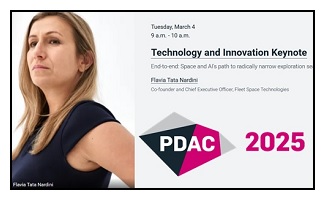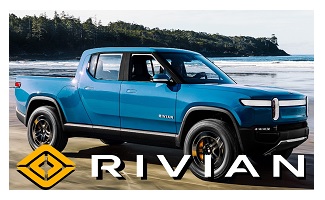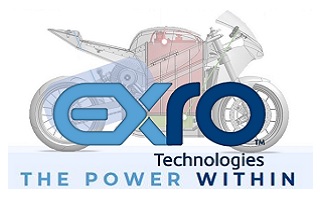 eResearch | Graphano Energy (TSXV:GEL | OTC:GELEF | FSE:97G0) is a Canadian-based mineral exploration company that is evaluating, acquiring, and developing battery metal projects after recently spinning out from Manganese X Energy Corp. (TSXV:MN) and raising over C$5.3 million in cash.
eResearch | Graphano Energy (TSXV:GEL | OTC:GELEF | FSE:97G0) is a Canadian-based mineral exploration company that is evaluating, acquiring, and developing battery metal projects after recently spinning out from Manganese X Energy Corp. (TSXV:MN) and raising over C$5.3 million in cash.
The company has said that it aims to build an energy metals portfolio as it develops its flagship project, the 100%-owned, Lac Aux Bouleaux (LAB) Graphite Property in the province of Quebec, Canada. Graphano’s properties have a documented history of having active deposits of natural graphite, which is one of the most sought-after technology minerals for green tech solutions.
Graphano’s focus is to supply graphite for anodes in Electric Vehicle (EV) Lithium-ion batteries for factories in North America to meet the demand of the growing green economy.
Historical Resource with High-Grade Potential
The LAB Graphite Project contains 14 mineral claims in one contiguous block covering over 738 hectares (1,823 acres), near the town of Mont-Laurier in southern Quebec, and within 150 kilometres of two major Canadian cities, Montreal and Ottawa.
Graphite mineralization around the LAB Graphite Project was originally discovered in 1957. Graphite showings on the property encouraged further exploration over the next decades, including stripping, diamond drilling, and bulk sampling.
In the early 1980s, Orrwell Energy Corporation reported a resource estimation, now a historical resource, of 1.32 million tonnes (Mt) at 9% graphitic carbon (Cg). Graphite Energy undertook an exploration program on the property, and surface sampling returned graphite carbon between 2.20% to 22.30%, and more recently, Graphano’s prospecting team has been able to get similar results from sampling and channeling.
Quebec’s Geology Supports Graphite Mining
Graphite is commonly found in the Grenville Province rocks throughout Quebec and has been commercially mined from several deposits located between Mont-Laurier in the north to the Ottawa River in the south. This geology makes Quebec a hotbed for graphite mining and exploration.
The region could become a key area for the domestic production of graphite, creating a stable and integrated North American value supply chain to meet the needs of North American EV manufacturers.
The LAB property is adjacent to the Lac des Iles graphite mine, operated by Imerys S.A. (ENXTPA:NK), the only active graphite mine in North America. Graphite ore is mined and concentrated into graphite products of various sizes and purities.
Other graphite projects in the Province of Quebec include Nouveau Monde’s (TSXV:NOU) Matawinie project, Lomiko Metals’ (TSXV:LMR) La Loutre project, and Canada Carbon’s (TSXV:CCB) Miller project.
FIGURE 1: Regional Property Location
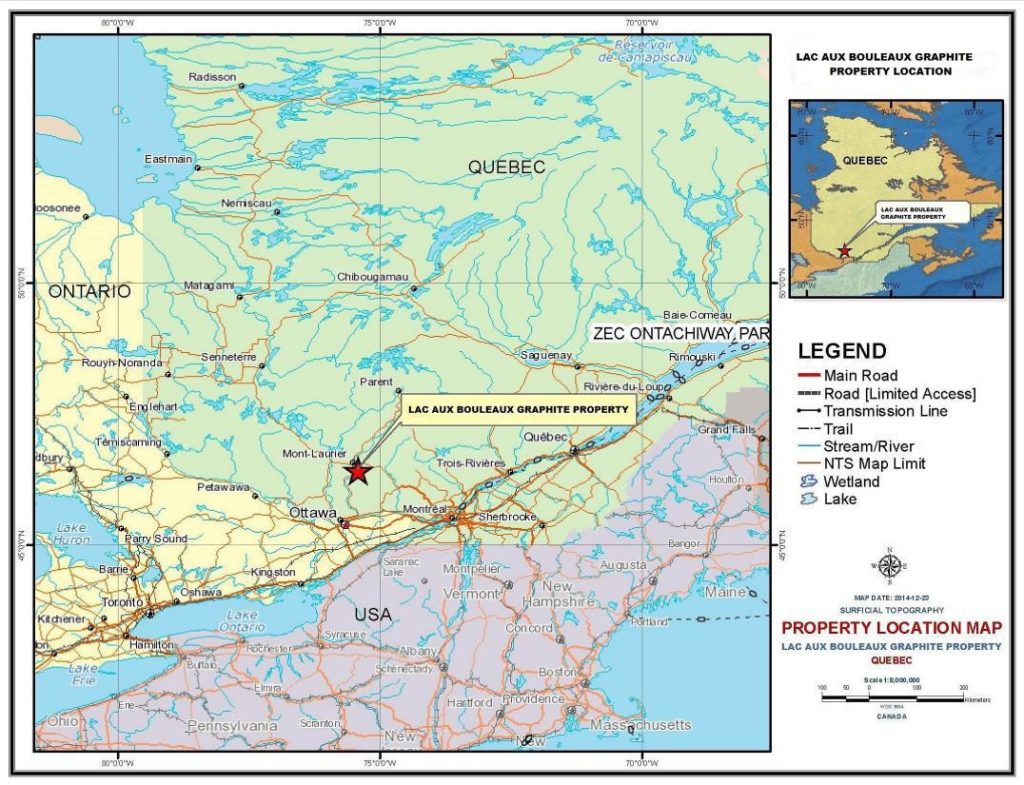
Recent Sale Supports Higher Valuation
In December 2021, Imerys announced an agreement to sell its Lac des Iles graphite mine to Northern Graphite Corporation (TSXV:NGC) for approximately €40.0 million (US$45.4 million). According to Imerys’ news release, the Lac des Iles mine generated approximately €15.0 million (US$17.0 million) of revenue per year from the sale of concentrate, in the last few years of production.
Currently, Northern Graphite is trading at a market cap of C$56 million (US$44 million).
Graphano: a Potential Acquisition Target
Northern Graphite reported that it is looking for acquisitions because the Lac des Iles mine only has three years of mine life remaining.
Graphano’s graphite claims are the closest to Imery’s processing plant. All of the other graphite projects are 50 to 100 km away, and it would be logistically challenging to transport mined material with 4-6% Cg over long distances.
Graphano also has non-compliant resources of 1.32 Mt at 8% Cg that could increase the Lac des Iles mine life by five years, while exploration efforts continue on new targets.
Infrastructure Already in Place, Lower CAPEX Requirements
With an operating mine next door, the infrastructure is already in place with rail and road links and an abundance of hydroelectric power, which means CAPEX requirements are lower when compared with most of the other graphite projects in the province that are in remote locations.
The LAB Property is accessible all year by road via a provincial highway from Montreal, and then secondary paved roads to reach the site.
EV and Green Tech’s Need for Graphite
Graphite is fuelling the clean technology revolution as it is a key component of lithium-ion batteries used in EVs.
Graphite is the primary material used for the anode due to its low cost and long cycle life. An average hybrid-electric (HEV) battery requires up to 10 kg of graphite, while a typical EV battery requires up to 70 kg of graphite.
In lithium-based batteries using graphite, graphite is the second-largest component in the battery by weight and most EV batteries require 14 times more graphite than lithium.
Besides EVs, other uses for lithium-ion batteries include battery storage systems for homes, another growing area. In addition, the demand for graphite continues to increase as it has other applications including brake linings for vehicles, high-temperature ceramics, lubricants, solar panels, the semiconductor industry, as an alloy material with aluminum, and pencils.
The Graphite Supply and Demand Imbalance
Graphano cited a market research report by Meticulous Research, which says that the EV industry is expected to grow annually at over 33% and hit US$2.5 trillion by 2027.
A World Bank report in 2020 highlighted that the energy transition to a low-carbon economy will lead to a significant rise in the demand for minerals such as nickel, iridium, vanadium, cobalt, lithium, and graphite.
In a report last year, Allied Market Research estimated that, driven by the growing EV adoption rate, the global graphite market should increase by at least 30% over the next five years to reach $21.6 billion by 2027, and graphite demand could double by 2035.
A recent CleanTechnica report stated that graphite demand from EV batteries could require a significant increase of up to 5 million tonnes per year. With current 2021 production estimated by the USGS at only 1 million tonnes per year, to meet this future demand, new graphite mines need to open annually over the next 10 years.
Figure 2: Minerals Demand Growth Required for Green Energy Transition (2018-2050)
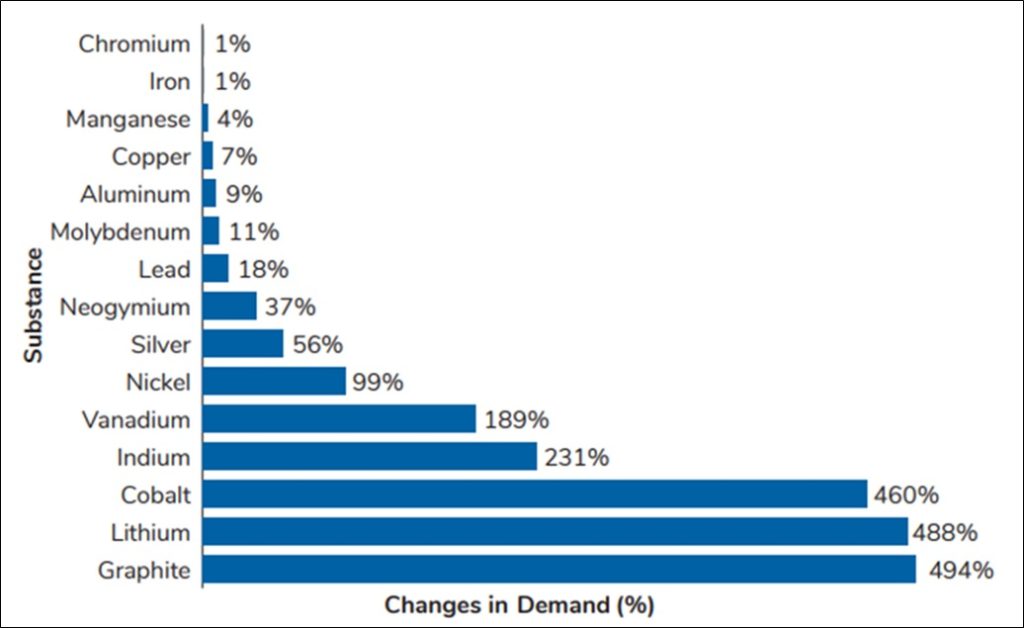
Size Matters
Not all graphite is created equal as there is flake graphite and also lump graphite. Large flake graphite is important as battery material needs to be of very high purity and larger flake material is inherently higher purity.
Previous work at the LAB Graphite Property confirmed that the mineralization contains natural, large flake graphite and preliminary metallurgical results returned very good results with recoveries up to 96% with a high purity concentrate that could be produced across all flakes by a simple flotation process.
In addition, the high percentage of large flake graphite is positive for a high-quality, premium-priced product. According to data from Fastmarkets IM, the price for 99% C (purity), 15 microns spherical graphite is US$3,100 to US$3,300 per tonne, much higher than the price of other forms of graphite that range from US$480 to US$1,395 per tonne.
Fully Funded Through 2022 for Exploration
As part of its go-public strategy, Graphano raised C$2.70 million in December 2020 and C$1.38 million in April 2021. To fund the company through this year’s exploration program, it completed a C$1.25 million financing in December 2021.
In 2021, Graphano completed a summer exploration campaign, which included channel sampling and ground geophysics to identify prime targets for drilling.
Key results from the sampling included assay results from about 295 samples that were in the range of 0.05% to 23.5% Cg with about 30% grading higher than 5% Cg.
Graphano is currently executing its Phase 2 exploration work that includes an initial drilling program and is focusing on high-priority targets identified from last year’s exploration. The company plans to complete approximately 20 holes totalling 2,800 metres (9,200 feet) as it works towards defining an NI 43-101 resource on the project.
Figure 3: Phase 2 Target and Airborne & Ground Geophysical Conductors
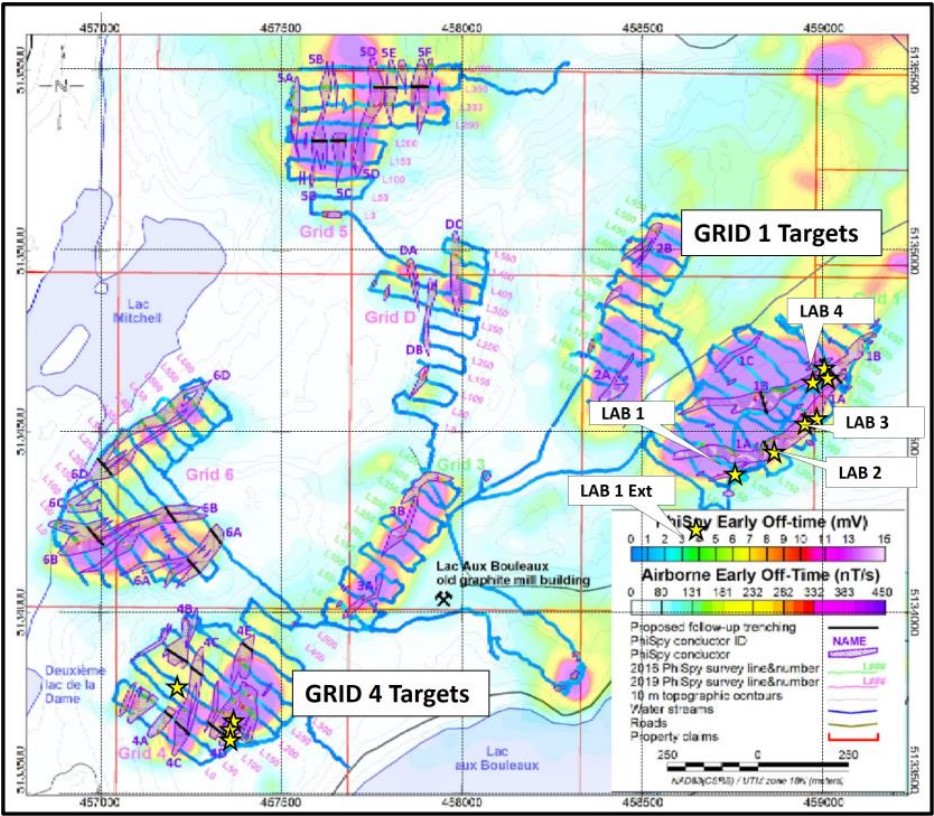
Graphano Valuation Comps
Graphano is currently trading at C$0.42 with a market cap of only C$7.0 million (US$5.5 million). In the highly active battery metals space, the company is relatively undervalued when compared with other graphite exploration companies operating in Quebec including Nouveau Monde with a market cap of C$480 million (US$377 million), Lomiko Metals with a market cap of C$19.5 million (US$15.3 million), and Focus Graphite (TSXV:FMS) with a market cap of C$38.6 million (US$30.3 million).
International comps include Syrah Resources Limited (ASX:SYR) with a market cap of A$888 million (US$640 million) and focused on the Balama graphite project in Mozambique, NextSource Materials Inc. (TSX:NEXT) with a market cap of C$430 million (US$337 million) and focused on the Molo Graphite Project in Madagascar, and Leading Edge Materials Corp. (TSXV:LEM) with a market cap of C$77.3 million (US$60.7 million) and focused on the Woxna Graphite mine in Sweden.
To learn more about Graphano and its LAB Graphite Project, visit www.graphano.com.
Notes: All numbers in CAD unless otherwise stated. The author of this report, and employees, consultants, and family of eResearch may own stock positions in companies mentioned in this article and may have been paid by a company mentioned in the article or research report. eResearch offers no representations or warranties that any of the information contained in this article is accurate or complete. Articles on eresearch.com are provided for general informational purposes only and do not constitute financial, investment, tax, legal, or accounting advice nor does it constitute an offer or solicitation to buy or sell any securities referred to. Individual circumstances and current events are critical to sound investment planning; anyone wishing to act on this information should consult with a financial advisor. The article may contain “forward-looking statements” within the meaning of applicable securities legislation. Forward-looking statements are based on the opinions and assumptions of the Company’s management as of the date made. They are inherently susceptible to uncertainty and other factors that could cause actual events/results to differ materially from these forward-looking statements. Additional risks and uncertainties, including those that the Company does not know about now or that it currently deems immaterial, may also adversely affect the Company’s business or any investment therein. Any projections given are principally intended for use as objectives and are not intended, and should not be taken, as assurances that the projected results will be obtained by the Company. The assumptions used may not prove to be accurate and a potential decline in the Company’s financial condition or results of operations may negatively impact the value of its securities. Please read eResearch’s full disclaimer.


